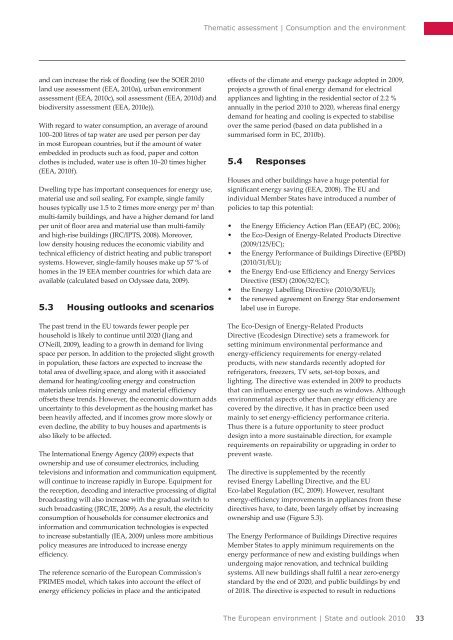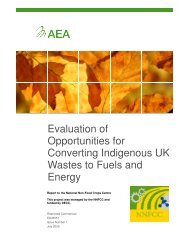Consumption and the environment (SOER2010) - European ...
Consumption and the environment (SOER2010) - European ...
Consumption and the environment (SOER2010) - European ...
Create successful ePaper yourself
Turn your PDF publications into a flip-book with our unique Google optimized e-Paper software.
Thematic assessment | <strong>Consumption</strong> <strong>and</strong> <strong>the</strong> <strong>environment</strong><br />
<strong>and</strong> can increase <strong>the</strong> risk of flooding (see <strong>the</strong> SOER 2010<br />
l<strong>and</strong> use assessment (EEA, 2010a), urban <strong>environment</strong><br />
assessment (EEA, 2010c), soil assessment (EEA, 2010d) <strong>and</strong><br />
biodiversity assessment (EEA, 2010e)).<br />
With regard to water consumption, an average of around<br />
100–200 litres of tap water are used per person per day<br />
in most <strong>European</strong> countries, but if <strong>the</strong> amount of water<br />
embedded in products such as food, paper <strong>and</strong> cotton<br />
clo<strong>the</strong>s is included, water use is often 10–20 times higher<br />
(EEA, 2010f).<br />
Dwelling type has important consequences for energy use,<br />
material use <strong>and</strong> soil sealing. For example, single family<br />
houses typically use 1.5 to 2 times more energy per m 2 than<br />
multi-family buildings, <strong>and</strong> have a higher dem<strong>and</strong> for l<strong>and</strong><br />
per unit of floor area <strong>and</strong> material use than multi‐family<br />
<strong>and</strong> high-rise buildings (JRC/IPTS, 2008). Moreover,<br />
low density housing reduces <strong>the</strong> economic viability <strong>and</strong><br />
technical efficiency of district heating <strong>and</strong> public transport<br />
systems. However, single-family houses make up 57 % of<br />
homes in <strong>the</strong> 19 EEA member countries for which data are<br />
available (calculated based on Odyssee data, 2009).<br />
5.3 Housing outlooks <strong>and</strong> scenarios<br />
The past trend in <strong>the</strong> EU towards fewer people per<br />
household is likely to continue until 2020 (Jiang <strong>and</strong><br />
O'Neill, 2009), leading to a growth in dem<strong>and</strong> for living<br />
space per person. In addition to <strong>the</strong> projected slight growth<br />
in population, <strong>the</strong>se factors are expected to increase <strong>the</strong><br />
total area of dwelling space, <strong>and</strong> along with it associated<br />
dem<strong>and</strong> for heating/cooling energy <strong>and</strong> construction<br />
materials unless rising energy <strong>and</strong> material efficiency<br />
offsets <strong>the</strong>se trends. However, <strong>the</strong> economic downturn adds<br />
uncertainty to this development as <strong>the</strong> housing market has<br />
been heavily affected, <strong>and</strong> if incomes grow more slowly or<br />
even decline, <strong>the</strong> ability to buy houses <strong>and</strong> apartments is<br />
also likely to be affected.<br />
The International Energy Agency (2009) expects that<br />
ownership <strong>and</strong> use of consumer electronics, including<br />
televisions <strong>and</strong> information <strong>and</strong> communication equipment,<br />
will continue to increase rapidly in Europe. Equipment for<br />
<strong>the</strong> reception, decoding <strong>and</strong> interactive processing of digital<br />
broadcasting will also increase with <strong>the</strong> gradual switch to<br />
such broadcasting (JRC/IE, 2009). As a result, <strong>the</strong> electricity<br />
consumption of households for consumer electronics <strong>and</strong><br />
information <strong>and</strong> communication technologies is expected<br />
to increase substantially (IEA, 2009) unless more ambitious<br />
policy measures are introduced to increase energy<br />
efficiency.<br />
The reference scenario of <strong>the</strong> <strong>European</strong> Commission's<br />
PRIMES model, which takes into account <strong>the</strong> effect of<br />
energy efficiency policies in place <strong>and</strong> <strong>the</strong> anticipated<br />
effects of <strong>the</strong> climate <strong>and</strong> energy package adopted in 2009,<br />
projects a growth of final energy dem<strong>and</strong> for electrical<br />
appliances <strong>and</strong> lighting in <strong>the</strong> residential sector of 2.2 %<br />
annually in <strong>the</strong> period 2010 to 2020, whereas final energy<br />
dem<strong>and</strong> for heating <strong>and</strong> cooling is expected to stabilise<br />
over <strong>the</strong> same period (based on data published in a<br />
summarised form in EC, 2010b).<br />
5.4 Responses<br />
Houses <strong>and</strong> o<strong>the</strong>r buildings have a huge potential for<br />
significant energy saving (EEA, 2008). The EU <strong>and</strong><br />
individual Member States have introduced a number of<br />
policies to tap this potential:<br />
• <strong>the</strong> Energy Efficiency Action Plan (EEAP) (EC, 2006);<br />
• <strong>the</strong> Eco-Design of Energy-Related Products Directive<br />
(2009/125/EC);<br />
• <strong>the</strong> Energy Performance of Buildings Directive (EPBD)<br />
(2010/31/EU);<br />
• <strong>the</strong> Energy End-use Efficiency <strong>and</strong> Energy Services<br />
Directive (ESD) (2006/32/EC);<br />
• <strong>the</strong> Energy Labelling Directive (2010/30/EU);<br />
• <strong>the</strong> renewed agreement on Energy Star endorsement<br />
label use in Europe.<br />
The Eco-Design of Energy-Related Products<br />
Directive (Ecodesign Directive) sets a framework for<br />
setting minimum <strong>environment</strong>al performance <strong>and</strong><br />
energy‐efficiency requirements for energy-related<br />
products, with new st<strong>and</strong>ards recently adopted for<br />
refrigerators, freezers, TV sets, set-top boxes, <strong>and</strong><br />
lighting. The directive was extended in 2009 to products<br />
that can influence energy use such as windows. Although<br />
<strong>environment</strong>al aspects o<strong>the</strong>r than energy efficiency are<br />
covered by <strong>the</strong> directive, it has in practice been used<br />
mainly to set energy-efficiency performance criteria.<br />
Thus <strong>the</strong>re is a future opportunity to steer product<br />
design into a more sustainable direction, for example<br />
requirements on repairability or upgrading in order to<br />
prevent waste.<br />
The directive is supplemented by <strong>the</strong> recently<br />
revised Energy Labelling Directive, <strong>and</strong> <strong>the</strong> EU<br />
Eco‐label Regulation (EC, 2009). However, resultant<br />
energy‐efficiency improvements in appliances from <strong>the</strong>se<br />
directives have, to date, been largely offset by increasing<br />
ownership <strong>and</strong> use (Figure 5.3).<br />
The Energy Performance of Buildings Directive requires<br />
Member States to apply minimum requirements on <strong>the</strong><br />
energy performance of new <strong>and</strong> existing buildings when<br />
undergoing major renovation, <strong>and</strong> technical building<br />
systems. All new buildings shall fulfil a near zero-energy<br />
st<strong>and</strong>ard by <strong>the</strong> end of 2020, <strong>and</strong> public buildings by end<br />
of 2018. The directive is expected to result in reductions<br />
The <strong>European</strong> <strong>environment</strong> | State <strong>and</strong> outlook 2010<br />
33








